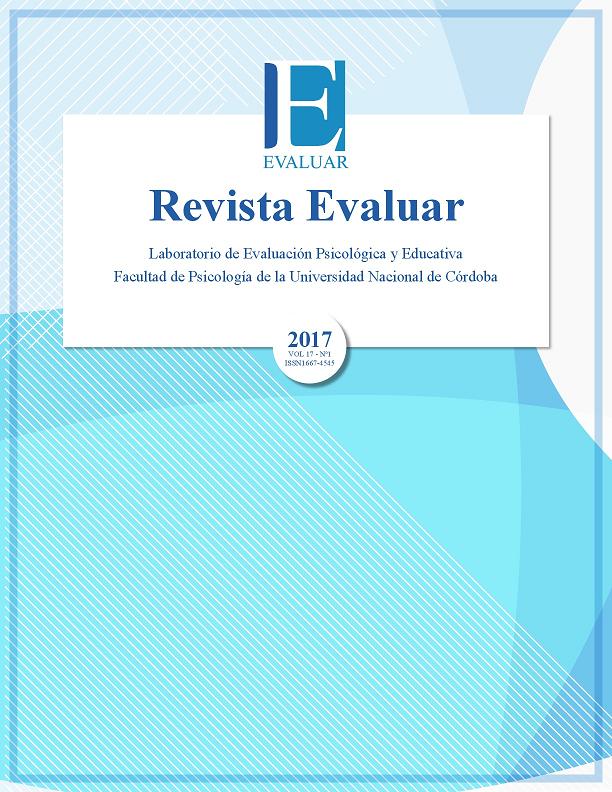Propiedades psicométricas de una escala sobre el material artístico y su uso para resolver problemas en sesiones de terapia de arte
DOI:
https://doi.org/10.35670/1667-4545.v17.n1.17073Palabras clave:
arte y terapia, validación psicométrica, solución de problemasResumen
El objetivo de este estudio fue generar un instrumento cuya validez y confiabilidad permitan evaluar el desarrollo de habilidades centradas en la solución de problemas mediante el uso de técnicas y material artístico dentro del espacio terapéutico. En una muestra de 216 participantes se validó una escala de 14 ítems con formato Likert. A partir del coeficiente alfa de Cronbach de .85 fue posible corroborar la consistencia interna de la escala, cuyos tres factores explican el 59.96% de la varianza total. No se encontraron diferencias significativas asociadas al género.
Descargas
Referencias
Alyami, A. (2009). The integration of art therapy into physical rehabilitation in a Saudi hospital. The Arts in Psychotherapy, 36(5), 282-288. doi: 10.1016/j.aip.2009.07.001
Betts, D. (2005). A systematic analysis of art therapy assessment and rating instrument literature. (Tesis doctoral). Recuperado de http://diginole.lib.fsu.edu/islandora/object/fsu:175923
Byrne, B. (2010). Structural equation modeling with AMOS. Basic concepts, applications, and programming. NY: Routldege.
Cano-García, F. J., Rodríguez-Franco, L., & García-Martínez, J. (2007). Adaptación española del Inventario de Estrategias de Afrontamiento. Acta Española de Psiquiatría, 35(1), 29-39. Recuperado de http://personal.us.es/fjcano/drupal/files/AEDP%2007%20(esp).pdf
Chinaveh, M. (2012). The effectiveness of problem-solving on coping skills and psychological adjustment. Procedia-Social and Behavioral Sciences, 84, 4-9. doi: 10.1016/j.sbspro.2013.06.499
Feen-Calligan, H., & Nevedal, D. (2008). Evaluation of an art therapy program: Client perceptions and future directions. Art Therapy, 25(4), 177-182. doi: 10.1080/07421656.2008.10129544
Field, A. (2016). An Adventure in Statistics: The Reality Enigma. Thousand Oaks, CA: Sage.
Gantt, L. M., & Anderson, F. (2009). The Formal Elements Art Therapy Scale: A measurement system for global variables in art. Art Therapy, 26(3), 124-129. doi: 10.1080/07421656.2009.10129372
IBM (2012). SPSS Statistics 21.0.0. [software de cómputo]. Recuperado de https://www-01.ibm.com/software/mx/analytics/spss/products/statistics/
IBM (2012). SPSS AMOS 21.0.0 [software de cómputo]. Recuperado de http://www.spss.com.hk/amos/in-dex.htm?tab=1
International Expressive Arts Therapy Association. (s.f.). What we do? Recuperado el 17 de Noviembre de 2016 de http://www.ieata.org/what-we-do.html
Johnson, D. R. (2009). Commentary: Examining underlying paradigms in the creative arts therapies of trauma. The Arts in Psychotherapy, 36(2), 114-120. doi: 10.1016/j.aip.2009.01.011
Kapitan, L. (2010). Introduction to Art Therapy Research. NY: Routledge.
Lloret-Segura, S., Ferreres-Traver, A., Hernández-Baeza, A., & Tomás-Marco, I. (2014). El análisis factorial exploratorio de los ítems: Una guía práctica, revisada y actualizada. Anales de Psicología, 30(3), 1151-1169. doi: 10.6018/analesps.30.3.199361
Malchiodi, C. A. (Ed.). (2005). Expressive Therapies. Nueva York, NY: Guilford Publication.
Marxen, E. (2011). Diálogos entre arte y terapia. Del "arte psicótico" al desarrollo de la arteterapia y sus aplicaciones. Barcelona, España: Gedisa.
Morales, P., & Jarpa, J. M. (2010). Elementos de Arteterapia como medio de comunicación y elaboración en psicoterapia con adolescentes. Arteterapia: Papeles de arteterapia y educación artística para la inclusión social, 5, 137-152. Recuperado de http://revistas.ucm.es/index.php/ARTE
Muri, S. A. (2007). Beyond the face: Art therapy and self-portraiture. The Arts in Psychotherapy, 34(4), 331-339. doi: 10.1016/j.aip.2007.05.002
Parto, M., & Besharat, M. A. (2011). The direct and indirect effects of self-efficacy and problem-solving on mental health in adolescents: Assessing the role of coping strategies as mediating mechanism. Procedia-Social and Behavioral Sciences, 30, 639-643. doi: 10.1016/j.sbspro.2011.10.124
Renton, A., Phillips, G., Daykin, N., Yu, G., Taylor, K., & Petticrew, M. (2012). Think of your arteries: Arts participation, behavioural cardiovascular risk factors and mental well-being in deprived communities in London. Public Health, 126, 557-664. doi: 10.1016/j.puhe.2012.05.025
Reynolds, M. W., Nabors, L., & Quinlan, A. (2000). The effectiveness of art therapy: Does it work? Art Therapy: Journal of the American Art Therapy Association, 17(3), 207-213. doi: 10.1080/07421656.2000.10129706
Snir, S., & Regev, D. (2013). ABI-Art-based Intervention Questionnaire. The Arts in Psychoterapy, 40(3), 338-346. doi: 10.1016/j.aip.2013.06.005
Spandler, H., Secker, J., Kent, L., Hacking, S., & Shenton, J. (2007). Catching life: The contribution of art initiatives to recovery approaches in mental health. Journal of Psychiatric and Mental Health Nursing, 14(8), 791-799. doi: 10.1111/j.1365-2850.2007.01174.x
Spector, P. (1992). Summated rating scale construction. An Introduction. Newbury Park, CA: Sage.
Stacey, G., & Stickley, T. (2010). The meaning of art to people who use mental health services. Perspectives in Public Health, 130(2), 70-77. doi: 10.1177/1466424008094811
Stickley, T., & Hui, A. (2012). Social prescribing through arts on prescription in a UK city: Participants’ perspectives (Part 1). Public Health, 126(7), 574-579. doi: 10.1016/j.puhe.2012.04.002
Stiles, W. B., Reynolds, S., Hardy, G. E., Rees, A., Barkham, M., & Shapiro, D. A. (1994). Evaluation and description of psychotherapy sessions by clients using the Session Evaluation Questionnaire and the Session Impacts Scale. Journal of Counseling Psychology, 41(2), 175-185. doi: 10.1037/0022-0167.41.2.175
Tucker, N., & Treviño, A. L. (2011). An art therapy domestic violence prevention group in Mexico. Journal of Clinical Art Therapy, 1(1), 16-24. Recuperado de http://digitalcommons.lmu.edu/jcat/
Uttley, L., Scope, A., Stevenson, M., Rawdin, A., Taylor-Buck, E., Sutton, A., & Wood, C. (2015). Systematic review and economic modelling of the clinical effectiveness and cost-effectiveness of art therapy among people with non-psychotic mental health disorders. Health Technology Assessment, 19(18), 1-120. doi: 10.3310/hta19180
Warson, E. (2003). From foster care to Indian boarding school: Empowering native youth. En D. Betts (Ed.), Creative art therapies approaches in adop-tion and foster care: Contemporary strategies for working with individuals and families (pp. 131-142). Springfield, IL: Charles C. Thomas.
Descargas
Publicado
Número
Sección
Licencia
Derechos de autor 2017 Minerva Vanegas-Farfano, Norma Cruz-Fierro, Mónica González-Ramírez

Esta obra está bajo una licencia internacional Creative Commons Atribución 4.0.
Revista Evaluar aplica la Licencia Internacional de Atribuciones Comunes Creativas (Creative Commons Attribution License, CCAL). Bajo esta licencia, los autores retienen la propiedad de copyright de los artículos pero permiten que, sin que medie permiso de autor o editor, cualquier persona descargue y distribuya los artículos publicados en Evaluar. La única condición es que siempre y en todos los casos se cite a los autores y a la fuente original de publicación (i.e. Evaluar). El envío de artículos a Evaluar y la lectura de los mismos es totalmente gratuito.



